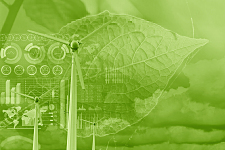Smart water management and forward-looking storage technologies for the Lune Delta green commercial zone/neighbourhood

The IWAS project aims to display the benefits of a fully climate-neutral supply to the Lune Delta neighbourhood in combination with a wind turbine.
To this end, the findings from the Hydrogen – Green Gas for Bremerhaven, Subproject H2 Microgrid study and the Sluice Drainage Demand Side Management feasibility study will be merged.
With a view to the attainment of the national climate targets, the Lune Delta commercial zone and adjacent areas form an area for the deployment of new green technologies in the context of the strategic orientation of the State of Bremen and the Bremerhaven region.
In the light of the preceding studies, and particularly with regard to the Lune Delta as a centre for a green economy and the goal of making the area as self-sufficient as possible and supplied exclusively with renewable energy, the current project points the way forward to the launch of a sustainable green energy supply. At the same time, the H2-Microgrid subproject in the ERDF-funded project entitled Hydrogen – green gas for Bremerhaven provides the platform for the autonomous energy supply of neighbouring areas and facilities.
In this project, a microgrid is to be designed for the green, self-sufficient energy supply, taking account of the consumers, generators and anticipated companies. Here, a storage solution consisting of hydrogen, battery, supercapacitor and drainage storage systems (the preceding sluice drainage project) is to be investigated in detail for the Lune Delta. The intention is to be able to supply the area with carbon-neutral green electricity at all times. Also, the project will study whether the microgrid is capable not only of ensuring the entire electricity supply, but also reliably delivering thermal energy to the commercial zone.
Secondly, a sluice in the drainage chain is to be rebuilt to provide an example of consumption-optimised pump logics and various operating scenarios for the equipment are to be studied.
In addition, a microgrid storage solution based on hydrogen and/or battery systems is to be designed for a sluice, e.g. the sluice at the mouth of the Lune, so that the pumps can be supplied with green electricity at all times. The combination of the microgrid and the sluice control can make a significant contribution towards grid stability via appropriate operating modes for a needs-based offsetting of peaks in demand and supply. In order to make the sustainable approach an integral aspect of the concept, the use of renewable energy, the needs-based/consumption-driven storage of the energy by means of hydrogen or battery technology, and the optimised and automated operation of the drainage pumps from a sluice in the drainage chain are to be linked together.
An analysis in the preceding project entitled Sluice Drainage Demand Side Management Feasibility Study showed that electrical energy from wind turbines can be used to operate sluices for 89.5 per cent of the time. This is because the sluice pumps are in operation at almost all times when the wind is blowing.
This means that sluices seem to be suited to taking off available electrical energy from wind turbines when needed (serving the grid). Also, by means of controlled drainage at suitable water levels, they can serve as ideal potential storage facilities for surplus wind energy, in this case for the Lune Delta.
In addition to the use of electrical energy from a wind turbine, consideration is being given to further potential for optimisation, such as the inclusion of precipitation forecast data and the staggered use of drainage pumps. This holistic approach results in an effective use of resources. By reducing the carbon footprint of the equipment, it also helps to improve the protection of the bodies of water and the coast. Particularly in view of the current increase in extreme weather, particularly heavy rainfall and flooding, a predictive operation of the drainage systems can result in a much higher level of safety.

This project focuses on crisis management and transformation to a greener and digital economy and is supported by our heroine Ronja.